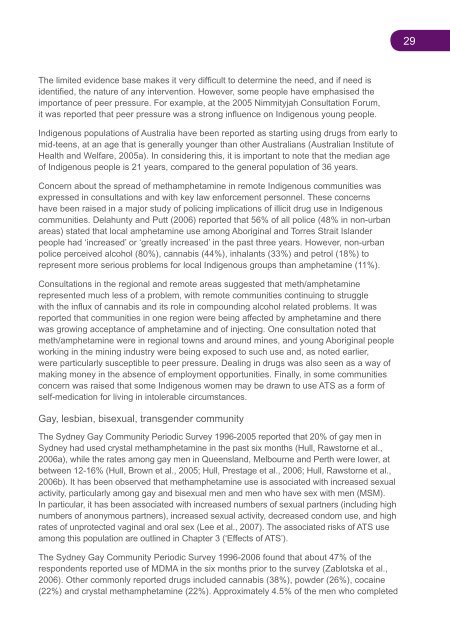National Amphetamine-Type Stimulant Strategy Background Paper
National Amphetamine-Type Stimulant Strategy Background Paper
National Amphetamine-Type Stimulant Strategy Background Paper
Create successful ePaper yourself
Turn your PDF publications into a flip-book with our unique Google optimized e-Paper software.
29<br />
The limited evidence base makes it very difficult to determine the need, and if need is<br />
identified, the nature of any intervention. However, some people have emphasised the<br />
importance of peer pressure. For example, at the 2005 Nimmityjah Consultation Forum,<br />
it was reported that peer pressure was a strong influence on Indigenous young people.<br />
Indigenous populations of Australia have been reported as starting using drugs from early to<br />
mid-teens, at an age that is generally younger than other Australians (Australian Institute of<br />
Health and Welfare, 2005a). In considering this, it is important to note that the median age<br />
of Indigenous people is 21 years, compared to the general population of 36 years.<br />
Concern about the spread of methamphetamine in remote Indigenous communities was<br />
expressed in consultations and with key law enforcement personnel. These concerns<br />
have been raised in a major study of policing implications of illicit drug use in Indigenous<br />
communities. Delahunty and Putt (2006) reported that 56% of all police (48% in non-urban<br />
areas) stated that local amphetamine use among Aboriginal and Torres Strait Islander<br />
people had ‘increased’ or ‘greatly increased’ in the past three years. However, non-urban<br />
police perceived alcohol (80%), cannabis (44%), inhalants (33%) and petrol (18%) to<br />
represent more serious problems for local Indigenous groups than amphetamine (11%).<br />
Consultations in the regional and remote areas suggested that meth/amphetamine<br />
represented much less of a problem, with remote communities continuing to struggle<br />
with the influx of cannabis and its role in compounding alcohol related problems. It was<br />
reported that communities in one region were being affected by amphetamine and there<br />
was growing acceptance of amphetamine and of injecting. One consultation noted that<br />
meth/amphetamine were in regional towns and around mines, and young Aboriginal people<br />
working in the mining industry were being exposed to such use and, as noted earlier,<br />
were particularly susceptible to peer pressure. Dealing in drugs was also seen as a way of<br />
making money in the absence of employment opportunities. Finally, in some communities<br />
concern was raised that some Indigenous women may be drawn to use ATS as a form of<br />
self-medication for living in intolerable circumstances.<br />
Gay, lesbian, bisexual, transgender community<br />
The Sydney Gay Community Periodic Survey 1996-2005 reported that 20% of gay men in<br />
Sydney had used crystal methamphetamine in the past six months (Hull, Rawstorne et al.,<br />
2006a), while the rates among gay men in Queensland, Melbourne and Perth were lower, at<br />
between 12-16% (Hull, Brown et al., 2005; Hull, Prestage et al., 2006; Hull, Rawstorne et al.,<br />
2006b). It has been observed that methamphetamine use is associated with increased sexual<br />
activity, particularly among gay and bisexual men and men who have sex with men (MSM).<br />
In particular, it has been associated with increased numbers of sexual partners (including high<br />
numbers of anonymous partners), increased sexual activity, decreased condom use, and high<br />
rates of unprotected vaginal and oral sex (Lee et al., 2007). The associated risks of ATS use<br />
among this population are outlined in Chapter 3 (‘Effects of ATS’).<br />
The Sydney Gay Community Periodic Survey 1996-2006 found that about 47% of the<br />
respondents reported use of MDMA in the six months prior to the survey (Zablotska et al.,<br />
2006). Other commonly reported drugs included cannabis (38%), powder (26%), cocaine<br />
(22%) and crystal methamphetamine (22%). Approximately 4.5% of the men who completed

















